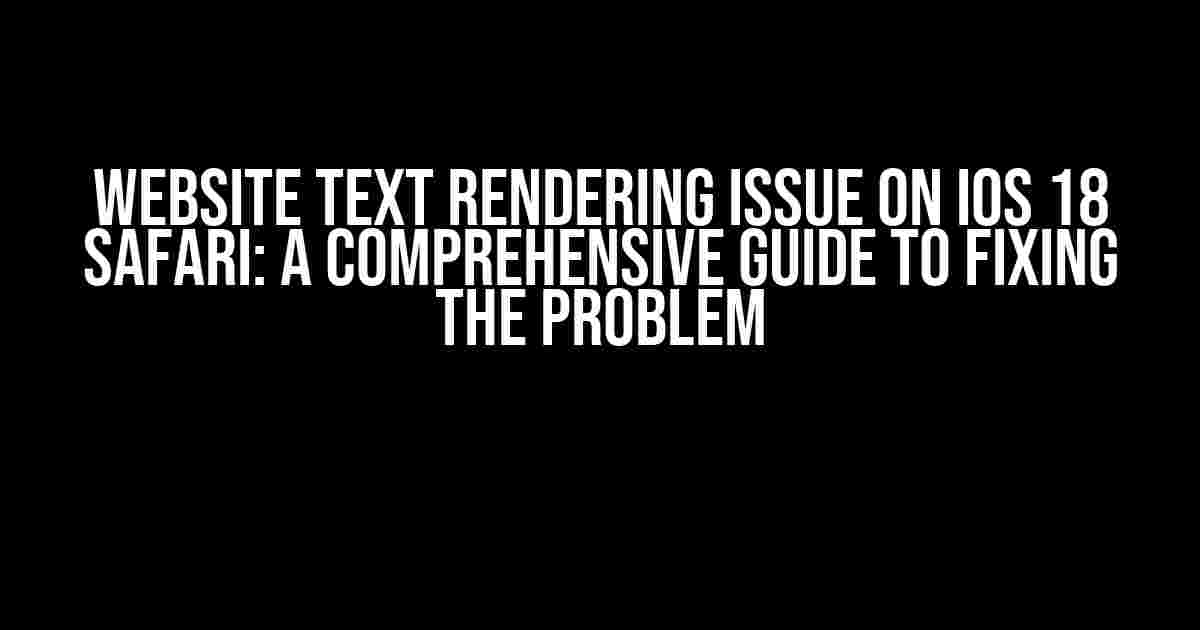Are you frustrated with the website text rendering issue on iOS 18 Safari? You’re not alone! Many website developers and owners have been struggling with this problem, and we’re here to help. In this article, we’ll dive deep into the reasons behind this issue and provide you with step-by-step instructions to fix it. So, let’s get started!
What is the Website Text Rendering Issue on iOS 18 Safari?
The website text rendering issue on iOS 18 Safari refers to the problem where the text on a website appears blurry, distorted, or overlapping on Apple devices running iOS 18 and accessing the website through the Safari browser. This issue can affect the user experience, making it difficult for visitors to read and navigate your website.
Causes of the Website Text Rendering Issue
Before we dive into the solutions, it’s essential to understand the causes of this issue. Here are some of the most common reasons why you might be experiencing text rendering problems on iOS 18 Safari:
- Incorrect font sizes and styles
- Insufficient font loading and rendering
- Layout and positioning issues
- Vendor prefix and compatibility problems
Virtually scaled font rendering
Step-by-Step Guide to Fixing the Website Text Rendering Issue
Now that we’ve covered the causes, let’s move on to the solutions. Follow these steps to fix the website text rendering issue on iOS 18 Safari:
Step 1: Optimize Font Sizes and Styles
Make sure to use relative font sizes (e.g., percentages, em, or rem) instead of fixed sizes (e.g., pixels). This will help the font adjust to different screen sizes and resolutions.
body {
font-size: 16px; /* or 100% */
}
Also, avoid using too many font styles, and make sure to declare the font family correctly:
body {
font-family: Arial, sans-serif;
}
Step 2: Ensure Proper Font Loading and Rendering
Use the `@font-face` rule to load your fonts correctly:
@font-face {
font-family: 'Open Sans';
src: url('opensans.woff2') format('woff2'),
url('opensans.woff') format('woff');
}
Additionally, use the `font-display` property to control font loading and rendering:
@font-face {
font-family: 'Open Sans';
src: url('opensans.woff2') format('woff2'),
url('opensans.woff') format('woff');
font-display: swap;
}
Step 3: Avoid Virtually Scaled Font Rendering
To prevent virtually scaled font rendering, add the following meta tag to your HTML header:
This will ensure that the font renders correctly and doesn’t get distorted.
Step 4: Fix Layout and Positioning Issues
Ensure that your website’s layout and positioning are correct. Avoid using absolute positioning and instead, use relative positioning or flexbox.
.container {
display: flex;
flex-direction: column;
align-items: center;
}
Step 5: Verify Vendor Prefix and Compatibility
Make sure to include vendor prefixes for maximum compatibility:
-webkit-font-smoothing: antialias;
-moz-osx-font-smoothing: grayscale;
font-smoothing: antialias;
Also, test your website on different iOS versions and Safari browsers to ensure compatibility.
Additional Tips and Tricks
In addition to the above steps, here are some extra tips to help you fix the website text rendering issue on iOS 18 Safari:
- Use a font loader or a plugin like Font Loader or Web Font Loader to load your fonts correctly.
- Avoid using font sizes that are too small or too large.
- Test your website on different devices and browsers to ensure compatibility.
- Use the Safari Developer Tools to inspect and debug your website’s font rendering issues.
Conclusion
Fixing the website text rendering issue on iOS 18 Safari requires attention to detail and a solid understanding of font loading, rendering, and styling. By following the steps outlined in this article, you should be able to resolve the issue and provide a better user experience for your website visitors. Remember to test and debug your website regularly to ensure that the issue doesn’t reoccur.
| Issue | Solution |
|---|---|
| Incorrect font sizes and styles | Use relative font sizes and declare font family correctly |
| Insufficient font loading and rendering | Use @font-face rule and font-display property |
| Virtually scaled font rendering | Add meta viewport tag to HTML header |
| Layout and positioning issues | Use relative positioning or flexbox |
| Vendor prefix and compatibility problems | Include vendor prefixes and test for compatibility |
We hope this article has been helpful in resolving the website text rendering issue on iOS 18 Safari. If you have any further questions or concerns, feel free to ask!
Here is the FAQ page about “Website text rendering issue on iOS 18 Safari” with creative voice and tone:
Frequently Asked Question
Get the scoop on the most puzzling issues with website text rendering on iOS 18 Safari!
What is the website text rendering issue on iOS 18 Safari, anyway?
The website text rendering issue on iOS 18 Safari refers to a frustrating glitch where website texts appear blurry, pixelated, or distorted on Safari browsers running on iOS 18 devices. It’s like trying to read a book through a blurry lens – not fun!
Is this issue specific to my website, or is it a Safari problem?
Good news: it’s not just your website! This issue is a known problem with Safari on iOS 18, affecting many websites. So, you’re not alone in this struggle. However, some websites might be more prone to this issue than others, depending on their design and coding.
What causes this text rendering issue on Safari?
The exact cause is still a mystery, but it’s suspected that the issue is related to Safari’s rendering engine, WebKit. Some theories point to a bug in the way Safari handles font loading, text rendering, or even the iOS 18 operating system itself. Hopefully, the Apple team is working on a fix as we speak!
Is there a workaround or fix for this issue?
While there’s no official fix yet, some web developers have found workarounds, such as tweaking font settings, adding custom CSS styles, or using specific font formats. You can also try updating your website’s design to be more Safari-friendly. If you’re not a techie, you can always reach out to your web developer for assistance.
When can I expect a fix from Apple?
As of now, Apple hasn’t officially acknowledged the issue or provided a timeline for a fix. But, fingers crossed, they might be working on it behind the scenes. Keep an eye on Apple’s developer forums, and we’ll let you know if we hear any updates!


